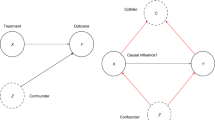Abstract
Causality is an essential concept in our understanding of the world as, in order to predict how a system behaves under an intervention, it is necessary to have causal knowledge of the impact of interventions. This knowledge should be expressed in a language built on top of probabilistic models, since the axioms of probability do not provide a way of expressing how external interventions affect a system. Learning this knowledge from data also poses additional challenges compared to the standard machine learning problem, as much data comes from passive observations that do not follow the same regime under which our predictions will take place.
Access this chapter
Tax calculation will be finalised at checkout
Purchases are for personal use only
Similar content being viewed by others
Recommended Reading
Chickering D (2002) Optimal structure identification with greedy search. J Mach Learn Res 3:507–554
Cooper G, Yoo C (1999) Causal discovery from a mixture of experimental and observational data. In: Proceedings of the 15th conference on uncertainty in artificial intelligencem (UAI-1999), Stockholm, pp 116–125
Dawid AP (2003) Causal inference using influence diagrams: the problem of partial compliance. In: Green PJ, Hjort NL, Richardson S (eds) Highly structured stochastic systems. Oxford University Press, New York, pp 45–65
Eaton D, Murphy K (2007) Exact Bayesian structure learning from uncertain interventions. In: Proceedings of the 11th international conference on artificial intelligence and statistics (AISTATS-2007), San Juan, pp 107–114
Entner D, Hoyer PO, Spirtes P (2012) Statistical test for consistent estimation of causal effects in linear non-gaussian models. In: Proceedings of the 15th international conference on artificial intelligence and statistics (AISTATS-2012), La Palma, pp 364–372
Halpern J, Pearl J (2005) Causes and explanations: a structural-model approach. Part II: explanations. Br J Philos Sci 56:889–911
Hyttinen A, Eberhardt F, Hoyer PO (2013) Experiment selection for causal discovery. J Mach Learn Res 14:3041–3071
Meek C (1997) Graphical models: selecting causal and statistical models. PhD thesis, Carnegie Mellon University
Pearl J (2000) Causality: models, reasoning and inference. Cambridge University Press, New York
Peters J, Mooij JM, Janzing D, Schölkopf B (2014) Causal discovery with continuous additive noise models. J Mach Learn Res 15:2009–2053
Richardson TS (1996) A discovery algorithm for directed cyclic graphs. In: Proceedings of 12th conference on uncertainty in artificial intelligence, Portland
Richardson TS, Robins J (2013) Single world intervention graphs (SWIGs): a unification of the counterfactual and graphical approaches to causality. Working Paper Number 128, Center for Statistics and the Social Sciences, University of Washington
Robins J, Scheines R, Spirtes P, Wasserman L (2003) Uniform consistency in causal inference. Biometrika 90:491–515
Rosenbaum P (2002) Observational studies. Springer, New York
Rubin D (2005) Causal inference using potential outcomes: design, modeling, decisions. J Am Stat Assoc 100(469):322–331
Sachs K, Perez O, Pe’er D, Lauffenburger D, Nolan G (2005) Causal protein-signaling networks derived from multiparameter single-cell data. Science 308:523–529
Shimizu S, Hoyer P, Hyvärinen A, Kerminen A (2006) A linear non-Gaussian acyclic model for causal discovery. J Mach Learn Res 7:2003–2030
Silva R, Scheines R, Glymour C, Spirtes P (2006) Learning the structure of linear latent variable models. J Mach Lear Res 7:191–246
Spirtes P, Glymour C, Scheines R (2000) Causation, prediction and search. MIT Press, Cambridge
Wasserman L (2004) All of statistics. Springer, New York
Zhang J, Spirtes P (2003) Strong faithfulness and uniform consistency in causal inference. In: Proceedings of the 19th conference in uncertainty in artificial intelligence (UAI-2013), Acapulco, pp 632–639
Author information
Authors and Affiliations
Corresponding author
Editor information
Editors and Affiliations
Rights and permissions
Copyright information
© 2017 Springer Science+Business Media New York
About this entry
Cite this entry
Silva, R. (2017). Causality. In: Sammut, C., Webb, G.I. (eds) Encyclopedia of Machine Learning and Data Mining. Springer, Boston, MA. https://doi.org/10.1007/978-1-4899-7687-1_36
Download citation
DOI: https://doi.org/10.1007/978-1-4899-7687-1_36
Published:
Publisher Name: Springer, Boston, MA
Print ISBN: 978-1-4899-7685-7
Online ISBN: 978-1-4899-7687-1
eBook Packages: Computer ScienceReference Module Computer Science and Engineering




